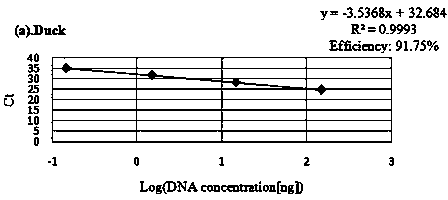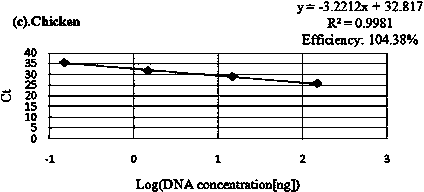Method for rapidly detecting chicken, duck and pig blood components in blood jelly
A blood component, rapid technology, applied in the direction of biochemical equipment and methods, material stimulation analysis, microbial measurement/testing, etc., can solve the problems of poor repeatability, difficult quantitative analysis, and simultaneous identification of multiple species, etc., to achieve operational Convenience, improved accuracy, good economic benefits and social effects
- Summary
- Abstract
- Description
- Claims
- Application Information
AI Technical Summary
Problems solved by technology
Method used
Image
Examples
Embodiment 1
[0033] 1) Sample preparation and DNA extraction
[0034] Preparation of Xuewang: Add 2% salt to the collected fresh blood, wait for it to coagulate into lumps, and then boil it with boiling water.
[0035] DNA extraction: operate in accordance with the instructions of the TIANGEN (Tiangen) kit. The total DNA of 50 mg of samples (blood, donkey, pork, rabbit, goose, fish, goat, sheep, corn) was dissolved in 100 μL TE buffer, and the DNA concentration and purity were detected by a nucleic acid protein analyzer.
[0036] 2) Primer and probe design
[0037] Based on the genome sequences of duck (accession number: HQ008784.1), pig (accession number: DQ452569.1) and chicken (accession number: AY685072.1) published in GenBank, specific primers and primers were designed using Primer Premier 5.0 software. Probes, and then the primers and probe sequences were compared and evaluated by Blast analysis on the NCBI website to ensure the specificity of the primers and probes. The fluoresce...
Embodiment 2
[0049] Example 2 Analysis of the actual lower limit of detection in real-time fluorescent PCR with multiplex TaqMan probes
[0050] The DNA template stock solutions extracted from duck, pig, and chicken blood (all at a concentration of 90 ng / μL) were mixed according to 1:1:1 and then serially diluted, that is, the DNA concentrations of the three animals were respectively 30 ng / μL, 3 ng / μL, Five concentration gradients of 0.3ng / μL, 0.03ng / μL and 0.003ng / μL were used to investigate the lower limit of detection with the optimized reaction system. In order to test the linearity of the system, a standard curve was constructed for the three species, and the amplification efficiency was calculated. The formula for calculating the amplification efficiency is (E)=10 -1 / 斜率 -1, the experiment was repeated three times, and three parallels were set up each time, and the Ct value less than 36 was used as the positive criterion.
[0051] The results showed (Table 3) that when the amount of ...
Embodiment 3
[0055] Example 3 Multiplex TaqMan probe real-time fluorescent PCR sensitivity analysis
[0056] Use fresh blood to make mixed blood samples of duck blood, pig blood and chicken blood with contents of 20%, 10%, 5%, 1%, 0.1% and 0% respectively (the content is the weight content of one of the blood, The weight ratio of the remaining two kinds of blood is 1:1), and the DNA of each group was extracted, and the sensitivity of the method was analyzed according to the optimized reaction system. The experiment was carried out three times, and three parallels were set up each time.
[0057] The Ct values obtained in the experiment are shown in Table 4. The results show that the system can detect 1% of duck blood, pig blood or chicken blood in Xuewang. Figure 5 , Figure 6 , Figure 7 It shows that the real-time fluorescent PCR amplification is good, and it can be confirmed that the sensitivity of this method can reach 1%, which can meet the actual detection needs.
[0058] Table ...
PUM
 Login to View More
Login to View More Abstract
Description
Claims
Application Information
 Login to View More
Login to View More - R&D
- Intellectual Property
- Life Sciences
- Materials
- Tech Scout
- Unparalleled Data Quality
- Higher Quality Content
- 60% Fewer Hallucinations
Browse by: Latest US Patents, China's latest patents, Technical Efficacy Thesaurus, Application Domain, Technology Topic, Popular Technical Reports.
© 2025 PatSnap. All rights reserved.Legal|Privacy policy|Modern Slavery Act Transparency Statement|Sitemap|About US| Contact US: help@patsnap.com



